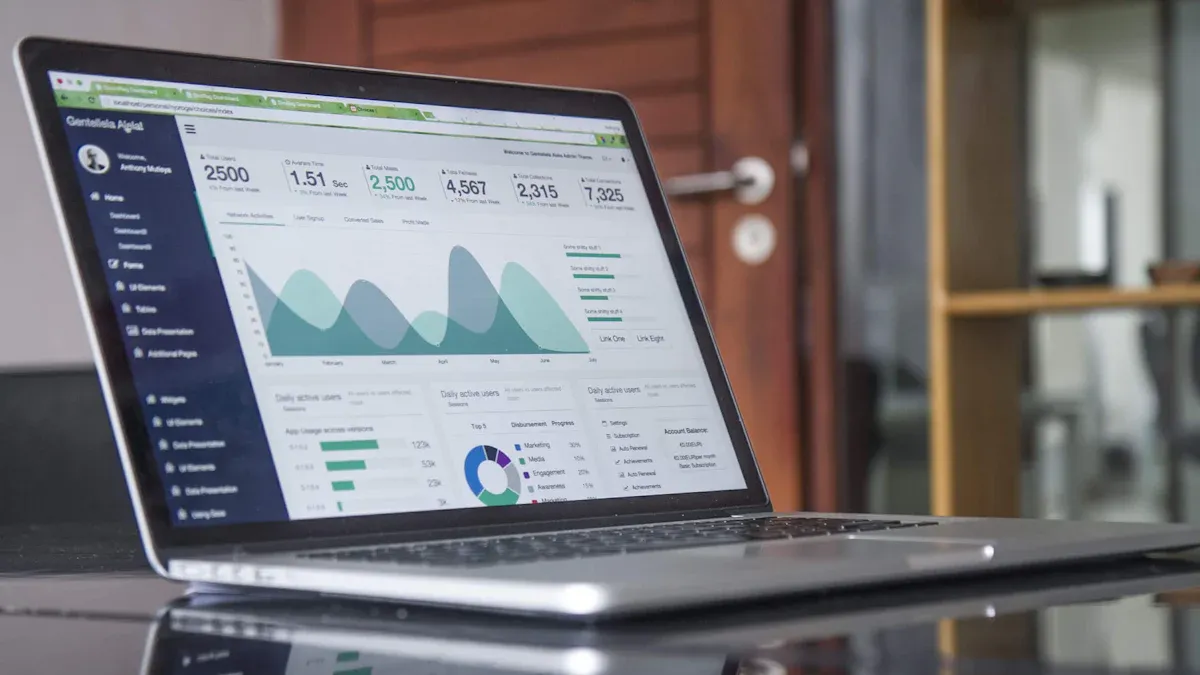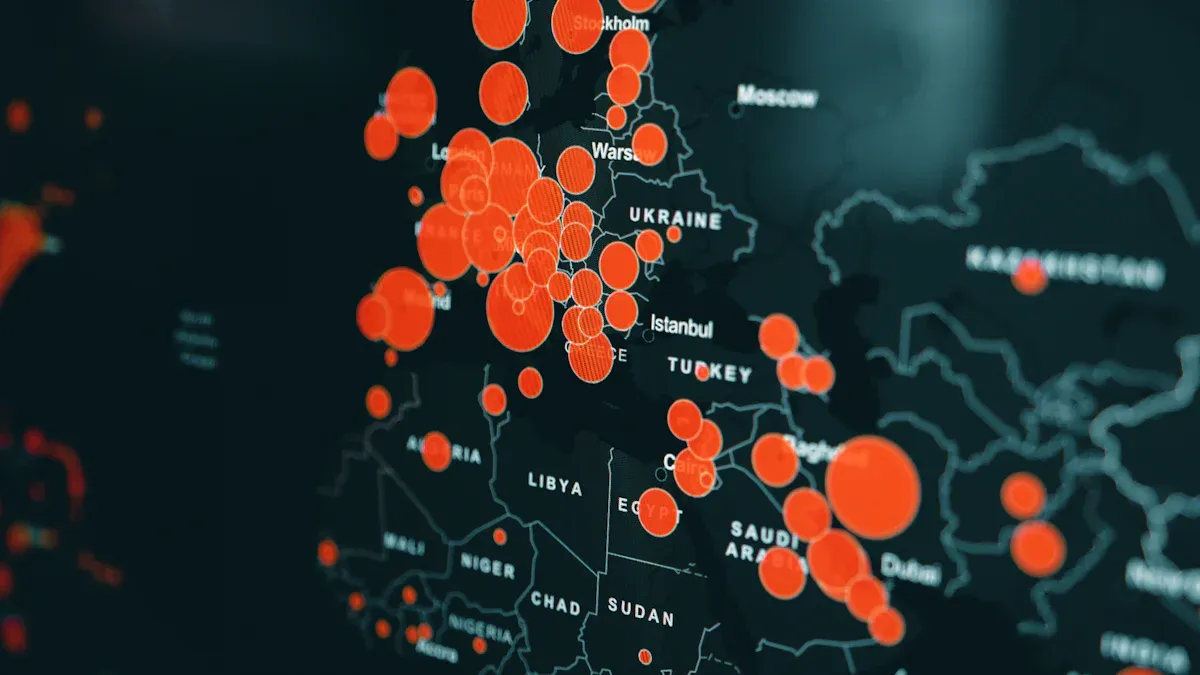
Public opinion monitoring plays a crucial role in shaping better decisions. It allows you to gather insights about people's views, preferences, and concerns. This process not only improves the efficiency of decision-making but also provides a multidimensional analysis that traditional methods often overlook. For example, automated systems for monitoring public opinion have proven effective in predicting election outcomes and future trends. By using these insights, you can make informed choices that align with what people truly value.
Key Takeaways
-
Watching public opinion helps you decide by knowing people's thoughts.
-
Social media tracking shows talks and feelings, helping you adjust fast.
-
Good surveys need clear goals and easy questions for true answers.
-
Mixing online and offline polls helps include everyone and stay accurate.
-
AI tools make opinion tracking faster with quick insights and feelings checks.
Social Media Listening for Public Opinion Monitoring
Understanding Social Media Listening
Social media listening involves tracking and analyzing conversations on platforms like Twitter, Facebook, and Instagram. It helps you understand what people are saying about specific topics, brands, or trends. By monitoring these discussions, you can gain insights into public sentiment and preferences. This method allows you to stay informed about emerging issues and adapt your strategies accordingly. For example, companies often use social media listening to identify customer concerns and address them in real time.
Tools for Social Media Listening
Several tools make social media listening easier and more effective. Platforms like Hootsuite, Brandwatch, and Sprout Social provide features to track mentions, hashtags, and keywords. These tools also use AI and machine learning to categorize sentiment and identify trends. Real-time alerts notify you of sudden shifts in public opinion, enabling quick responses. Additionally, some tools offer competitive analysis, helping you understand how your brand compares to others in the market.
Benefits of Social Media Listening
Social media listening offers numerous benefits for public opinion monitoring. It measures sentiment by analyzing positive, neutral, and negative mentions. This gives you a clear picture of how people feel about a topic or brand. It also tracks reach, showing how many people see your content, and engagement, which reflects audience interaction. Companies like JetBlue Airways use this method to improve customer service, while Starbucks leveraged it to launch the successful Pumpkin Spice Latte. By understanding public sentiment, you can make informed decisions and identify new opportunities. Studies show that combining social listening with targeted marketing can increase returns on investment by up to 50%.
Public Opinion Polling Through Surveys
Designing Effective Surveys
Creating an effective survey is essential for gathering reliable data in public opinion polling. A well-designed survey ensures that respondents provide accurate and relevant information. Start by defining a clear research objective. This helps you avoid irrelevant questions that could confuse respondents or lower response rates. Use simple, direct language to make questions easy to understand. For example, instead of asking, “What are your thoughts on the current socio-economic policies?” you could ask, “Do you think current economic policies are beneficial?”
Incorporate both quantitative and qualitative questions to capture a range of insights. Quantitative questions, like multiple-choice or rating scales, provide measurable data. Qualitative questions, such as open-ended ones, allow respondents to share detailed opinions. To improve response rates, consider offering incentives or keeping the survey short. Extensive planning and effort during the design phase lead to meaningful results that support informed decision-making.
Online vs. Offline Polling
Choosing between online and offline polling depends on your target audience and resources. Online polling is cost-effective and reaches a broader audience. Platforms like Google Forms or SurveyMonkey make it easy to distribute surveys and collect responses quickly. However, it may exclude individuals without internet access, leading to potential bias.
Offline polling, such as in-person or telephone surveys, provides access to respondents who may not be online. This method often yields higher response rates and allows for clarifying questions in real time. However, it requires more time and resources. Combining both methods can help you achieve a balanced approach, ensuring inclusivity and accuracy in public opinion polling.
Advantages of Public Opinion Polling
Public opinion polling offers several benefits for public opinion monitoring. It provides a structured way to understand collective opinions on various topics. For instance, opinion polls gauge public sentiment by asking the same questions to a representative sample. Benchmark polls identify voter demographics and guide campaign strategies. Bushfire polls capture real-time opinions on urgent issues, while entrance and exit polls analyze voter behavior during elections.
|
Poll Type |
Purpose |
Methodology Description |
|---|---|---|
|
Opinion Poll |
To represent the target audience accurately and gauge public sentiment. |
Involves asking the same questions to a representative sample to understand collective opinions. |
|
Benchmark Poll |
To identify voter demographics and guide campaign strategies. |
Conducted before a campaign to assess the current standing and inform future strategies. |
|
Bushfire Poll |
To gather real-time public opinions on urgent issues. |
Conducted post-event to assess immediate public sentiment and needs, using flexible data collection methods. |
|
Entrance Poll |
To forecast election results and understand voter behavior. |
Conducted at polling stations to gather data on voter preferences just before voting. |
|
Exit Poll |
To analyze voter behavior and maintain election integrity. |
Conducted immediately after voting to assess preferences and turnout, serving as a fraud detection tool. |
Public opinion polls help you identify trends, predict outcomes, and make data-driven decisions. By understanding the views of your audience, you can tailor strategies to meet their needs effectively.
Sentiment Analysis in Public Opinion Monitoring
How Sentiment Analysis Works
Sentiment analysis, also known as opinion mining, helps you understand emotions expressed in text data. It uses Natural Language Processing (NLP) techniques to convert human language into a machine-readable format. Machine learning models then classify the processed text into categories like positive, negative, or neutral.
Several methods make sentiment analysis effective:
-
AI tools extract specific words or phrases to detect sentiment automatically.
-
Libraries like SnowNLP calculate sentiment scores ranging from 0 to 1, where scores above 0.5 indicate positive sentiment and scores below 0.5 indicate negative sentiment.
-
These systems identify patterns in text data, enabling accurate predictions of public sentiment.
By analyzing subjective texts, sentiment analysis provides emotional insights that are crucial for measuring public opinion.
Tools for Sentiment Analysis
You can use various tools to perform sentiment analysis effectively. Thematic’s sentiment analysis tool, for example, achieves an accuracy rate of 96% in predicting sentiment. It uses aspect-based analysis, which aligns with human annotators better than they agree with each other.
Other tools include:
-
SnowNLP: Ideal for analyzing sentiment in Chinese-language texts.
-
MonkeyLearn: Offers customizable sentiment analysis for diverse industries.
-
Lexalytics: Provides advanced NLP features for large-scale text analysis.
These tools simplify the process of measuring public opinion by automating sentiment detection and delivering actionable insights.
Benefits of Sentiment Analysis
Sentiment analysis offers several advantages for public opinion monitoring. It helps you make critical business decisions, such as launching new products or modifying existing ones based on customer feedback. It also influences customer decisions, as reviews often impact purchasing behavior.
|
Benefit of Sentiment Analysis |
Description |
|---|---|
|
Critical Business Decisions |
Helps launch or modify products based on feedback or withdraw them if needed. |
|
Influence on Customer Decisions |
Highlights the importance of user-generated content in shaping purchasing behavior. |
|
Direct Access to Customer Feedback |
Allows producers to analyze marketing strategies directly from customer comments. |
By leveraging sentiment analysis, you can gain direct access to valuable insights, enabling you to refine your strategies and improve outcomes.
Focus Groups for Public Opinion Insights
Setting Up Focus Groups
Focus groups are a powerful way to gather public opinion. To set one up, you need to define a clear objective. This ensures the discussion stays focused and productive. Next, recruit participants who represent your target audience. Aim for a diverse group of 6-12 people to encourage varied perspectives. Prepare a list of open-ended questions to guide the conversation. For example, instead of asking, “Do you like this product?” you could ask, “What features of this product stand out to you?”
A skilled moderator is essential for managing the discussion. They should create a comfortable environment where participants feel free to share their thoughts. Recording the session is also important. It allows you to revisit the discussion for a deeper analysis later.
Analyzing Feedback from Focus Groups
Analyzing feedback from focus groups requires a systematic approach. Start by transcribing the recorded discussions. This helps you capture every detail. Look for recurring themes or patterns in the responses. For example, if multiple participants mention a specific feature, it likely holds significant importance.
Qualitative data analysis methods, such as coding, help you organize and interpret the feedback. Statistical techniques like regression analysis can also identify relationships between variables. These methods provide insights that guide critical decisions. Unlike surveys or polling, focus groups capture the nuances of human experiences, offering a richer understanding of public opinion.
Benefits of Focus Groups
Focus groups offer several advantages. They leverage group dynamics to generate ideas and uncover insights that other methods might miss. Participants often build on each other's thoughts, leading to more in-depth discussions. This makes focus groups particularly effective in the early stages of research.
Additionally, focus groups provide a platform for exploring complex social phenomena. They allow you to understand individual perspectives within a broader social context. By using this approach, you can gain actionable insights that drive informed decision-making.
Media Monitoring for Public Opinion Trends
Tracking Media Coverage
Tracking media coverage allows you to identify shifts in public sentiment and emerging trends. By analyzing articles, broadcasts, and online content, you can uncover how the media portrays specific topics. For example, during the COVID-19 pandemic, a surge in unemployment-related articles in March 2020 coincided with a peak in unemployment rates. This correlation highlights how media coverage reflects public concerns.
Media monitoring also helps you measure the emotional tone of coverage through sentiment analysis. Metrics like sentiment scores and media impact scores provide valuable insights into public feelings and the effectiveness of PR efforts. These tools enable you to respond proactively to changes in public opinion, ensuring your strategies remain relevant and impactful.
|
Metric |
Description |
|---|---|
|
Sentiment Analysis |
Measures the emotional tone of media coverage, indicating public feelings towards topics. |
|
Quantifies the effectiveness of PR efforts, reflecting trends in public perception. |
|
|
Tracking Media Coverage |
Helps identify shifts in public opinion over time, allowing for timely responses to changes. |
Tools for Media Monitoring
Media monitoring tools simplify the process of gathering and analyzing data. Features like real-time alerts ensure you can act swiftly when your brand or topic is mentioned. Analytics and reporting tools provide insights into reach, impressions, and engagement, helping you assess the effectiveness of your PR efforts.
Some tools also offer predictive analytics, which forecast trends and measure long-term impacts. Custom visualizations and reports enhance decision-making by presenting data in an accessible format. By integrating these tools into your workflow, you can track sentiment, salience, and volume to understand public opinion trends more effectively.
|
Feature |
Description |
|---|---|
|
Analytics and Reporting |
Provides comprehensive insights into PR efforts, including reach, impressions, and engagement. |
|
Real-Time Alerts |
Enables timely responses to media mentions, ensuring PR professionals can act swiftly. |
|
Sentiment Analysis |
Deciphers the tone of content, helping assess public perception quickly and accurately. |
How Media Monitoring Supports Decision-Making
Media monitoring plays a crucial role in shaping informed decisions. By analyzing media coverage, you can gauge public sentiment towards policies, organizations, or campaigns. For instance, federal agencies have used media monitoring to improve communication strategies for health programs. Similarly, insights from media analysis helped leaders tailor outreach efforts for childhood disease prevention programs.
Case studies demonstrate its impact on strategic communications. The U.S. Army Command utilized media monitoring to adjust messaging based on public perception. Continuous analysis enabled real-time decision-making, ensuring effective communication with key audiences. These examples show how media monitoring empowers you to make data-driven decisions that align with public needs and expectations.
Tip: Incorporate media monitoring into your methods to stay ahead of public opinion trends and improve your decision-making processes.
Public Forums and Online Communities
Identifying Relevant Forums
Public forums and online communities are treasure troves of public opinion. To identify the most relevant ones, you need a systematic approach. Start by gathering data from various platforms to understand where your target audience actively participates. Use thematic analysis to categorize recurring issues or positive remarks. This helps you pinpoint forums that align with your research goals. Presenting findings in a digestible format ensures you can make informed decisions about which communities to monitor.
Popular platforms like Reddit, Quora, and niche-specific forums often host discussions that reflect public sentiment. For example, if you’re researching consumer opinions on technology, forums like TechRadar or Android Central can provide valuable insights. By focusing on forums where your audience engages most, you can maximize the effectiveness of your monitoring methods.
Engaging with Online Communities
Engagement is key to unlocking the full potential of online communities. Successful engagement involves tracking metrics that reflect community activity and vibrancy.
|
Metric |
Description |
|---|---|
|
Tracks how often members post and the quality of their contributions. High-quality posts lead to more meaningful interactions. |
|
|
Comment and reaction rates |
Measures the number of comments and reactions each post receives, indicating content engagement. |
|
Member participation rates |
Calculates the percentage of active members participating in discussions, reflecting community vibrancy. |
User-generated content (UGC) is another critical metric. It shows how actively members share their thoughts and experiences. A higher UGC rate indicates greater engagement and provides richer data for analysis. Additionally, the Net Promoter Score (NPS) can help you assess member satisfaction. Communities with higher NPS scores often foster deeper discussions and more meaningful interactions.
Insights from Public Forums
Public forums generate rich, user-generated content that offers qualitative insights into public opinion. These platforms allow users to express their views, share advice, and recount experiences. By analyzing discussions, you can uncover trends and common themes related to customer experiences and sentiments.
For example, a thread discussing a product’s features might reveal recurring complaints or praise. These insights can guide product development or marketing strategies. Forums also provide a window into emerging issues, helping you stay ahead of public concerns. By leveraging these platforms, you gain a deeper understanding of your audience’s needs and preferences.
Tip: Focus on forums with active participation and diverse discussions to ensure your analysis captures a wide range of opinions.
Website Analytics for Public Opinion Monitoring
Using Website Traffic Data
Website traffic data offers valuable insights into public opinion. By analyzing visitor behavior, you can uncover trends that reflect audience preferences and concerns. For instance:
-
Web traffic analytics reveal how many visitors access your site over time.
-
They track the duration users spend on specific pages, highlighting areas of interest.
-
They identify which content is most consumed by users, helping you prioritize topics.
-
They show which elements cause users to leave the site, enabling you to address potential issues.
-
They monitor how frequently users return to the site, indicating loyalty and engagement.
These insights allow you to refine your strategies and create content that resonates with your audience. For example, if a page discussing survey methods receives high traffic, you can expand on related topics to meet user demand.
Tools for Website Analytics
Website analytics tools simplify the process of gathering actionable insights. They empower you to make strategic decisions by streamlining operations, anticipating trends, and mitigating risks. Consider these tools:
-
ThoughtSpot: AI-driven analytics that surface insights instantly from large datasets.
-
Tableau: Offers interactive dashboards and integrates with multiple data sources for streamlined analysis.
-
Power BI: Provides real-time dashboards and integrates seamlessly with Microsoft tools.
These tools enhance your ability to monitor public opinion effectively. For example, Tableau’s interactive dashboards can help you visualize polling data trends, while ThoughtSpot’s AI capabilities allow you to identify emerging topics quickly.
Benefits of Website Analytics
Website analytics deliver measurable impacts that improve decision-making and drive growth.
|
Measurable Impact |
Description |
|---|---|
|
Improved Digital Marketing Efforts |
On-site and off-site analytics provide insights that enhance marketing strategies. |
|
Enhanced User Experience |
Analytics help in understanding visitor behavior, leading to better website performance. |
|
Business Growth |
By refining strategies based on analytics, businesses can drive growth and improve conversion rates. |
For example, understanding visitor behavior can help you optimize pages discussing survey methods or polling techniques, leading to higher engagement and better outcomes. By leveraging website analytics, you can align your strategies with audience needs and achieve long-term success.
Text Mining for Public Opinion Analysis
What is Text Mining?
Text mining is a method that extracts valuable insights from large volumes of text data. It uses algorithms to process unstructured information, such as social media posts, news articles, or customer reviews. By analyzing patterns and trends, text mining helps you understand public sentiment and identify emerging topics. For example, it can detect recurring keywords in online discussions, revealing what people care about most. This approach transforms raw text into actionable knowledge, making it easier to monitor public opinion effectively.
Applications of Text Mining
You can apply text mining in various ways to analyze public opinion. It helps businesses understand customer feedback by categorizing reviews into positive, negative, or neutral sentiments. Governments use it to track public reactions to policies or events. For instance, during elections, text mining can analyze social media posts to gauge voter sentiment. It also supports crisis management by identifying early signs of public concern.
Adoption statistics highlight its efficiency. Text mining achieves an 82% agreement rate with human annotations. Out of 150 samples, 123 matched human evaluations. For positive sentiment, 37 samples aligned with text mining results. Negative tweets showed 45 out of 50 agreements, while neutral tweets had 41 matches. These metrics demonstrate how text mining provides reliable insights for decision-making.
Advantages of Text Mining
Text mining offers several benefits for public opinion monitoring. It processes vast amounts of data quickly, saving you time and resources. It also reduces human bias by relying on algorithms to analyze text objectively. This ensures accurate results, even when dealing with complex datasets.
Another advantage is its ability to uncover hidden trends. By analyzing subtle patterns in text, text mining reveals insights that traditional methods might miss. For example, it can identify shifts in sentiment over time, helping you adapt your strategies to changing public opinions. With its efficiency and reliability, text mining empowers you to make informed decisions based on real-world data.
Expert Panels for Public Opinion Monitoring
Organizing Expert Panels
Expert panels provide a structured way to gather insights from professionals in specific fields. To organize one, start by identifying experts who have relevant knowledge about your topic. Look for individuals with proven experience or credentials. Invite them to participate in a discussion or workshop. Keep the group size manageable, ideally between 5 and 10 members, to ensure productive conversations.
Prepare a clear agenda before the session. Include key questions or topics you want the panel to address. For example, if you’re exploring public health opinions, ask experts to evaluate recent trends or suggest solutions. Use a moderator to guide the discussion and keep it focused. Record the session to capture all insights for later analysis.
Leveraging Expert Opinions
Expert opinions add depth to public opinion monitoring. Use their insights to validate findings from other methods, such as surveys or sentiment analysis. For example, if polling data shows a shift in public sentiment, experts can explain the underlying reasons. Their perspectives help you interpret complex issues and make informed decisions.
You can also use expert panels to predict future trends. Professionals often have a unique ability to foresee changes based on their experience. For instance, marketing experts might identify emerging consumer preferences before they become widespread. By leveraging expert opinions, you gain a strategic advantage in understanding public sentiment.
Benefits of Expert Panels
Expert panels offer several benefits for public opinion monitoring. They provide specialized knowledge that complements other methods. Experts can identify gaps in your data and suggest ways to address them. Their feedback often leads to actionable recommendations.
Panels also foster collaboration. Experts from different fields bring diverse perspectives, enriching the discussion. This diversity helps you understand public opinion from multiple angles. Additionally, expert panels build credibility. Decision-makers often trust insights backed by professional expertise. By using expert panels, you enhance the accuracy and reliability of your public opinion monitoring efforts.
Tip: Combine expert panels with other methods to create a comprehensive approach to public opinion monitoring.
AI and Machine Learning in Public Opinion Monitoring

How AI Enhances Public Opinion Monitoring
AI has revolutionized how you can monitor public opinion. It processes vast amounts of data quickly, providing insights that would take humans weeks to uncover. AI-powered algorithms analyze text, images, and even videos to detect patterns and trends. For example, Natural Language Processing (NLP) helps you understand the sentiment behind social media posts or customer reviews. Machine learning models improve over time, ensuring more accurate predictions and analyses.
AI also enables real-time monitoring. You can track public sentiment as it evolves, allowing you to respond promptly to changes. This is especially useful during crises or major events when public opinion shifts rapidly. By using AI, you can adopt methods that are faster, more efficient, and less prone to human error.
Examples of AI Tools
Several AI tools can help you monitor public opinion effectively.
-
IBM Watson: This tool uses NLP to analyze text data and extract sentiment, tone, and key topics.
-
Google Cloud Natural Language: It provides sentiment analysis and entity recognition, making it easier to understand public discussions.
-
Crimson Hexagon: This platform specializes in social media analytics, offering insights into trends and audience behavior.
-
Brandwatch Consumer Research: It combines AI with social listening to deliver actionable insights from online conversations.
These tools simplify the process of gathering and analyzing data, helping you make informed decisions based on public sentiment.
The Future of AI in Public Opinion Analysis
AI will continue to shape the future of public opinion monitoring. As technology advances, AI systems will become even more accurate and versatile. Predictive analytics will allow you to forecast public sentiment before it fully emerges. AI will also integrate with other technologies, such as augmented reality, to provide immersive ways to understand public opinion.
Ethical considerations will play a larger role as AI evolves. Ensuring transparency and fairness in AI-driven methods will be crucial. By staying updated on these advancements, you can leverage AI to stay ahead in understanding public sentiment.
Public opinion monitoring helps you understand people's views and make better decisions. The ten methods discussed in this blog offer diverse ways to gather insights, from social media listening to expert panels. Each method serves unique purposes, so choosing the right one depends on your goals and the context of your research. By applying these methods, you can stay informed and adapt your strategies to meet public needs effectively.
Tip: Start small by implementing one method and gradually expand your approach as you gain confidence.
FAQ
What is the best method for monitoring public opinion?
The best method depends on your goals. Social media listening works well for real-time insights, while surveys provide structured data. Combining methods like sentiment analysis and expert panels can give you a comprehensive view.
How often should you monitor public opinion?
You should monitor public opinion regularly. For ongoing campaigns, weekly or monthly checks work well. During crises or major events, daily monitoring ensures you stay updated on rapid changes.
Are free tools effective for public opinion monitoring?
Free tools can be effective for basic monitoring. Platforms like Google Alerts or Hootsuite’s free version provide useful insights. However, advanced tools with AI capabilities offer deeper analysis and better accuracy.
How do you ensure data accuracy in public opinion monitoring?
Use multiple methods to cross-verify data. For example, combine survey results with sentiment analysis. Always ensure your sample size is representative of your target audience to reduce bias.
Can small businesses benefit from public opinion monitoring?
Absolutely! Small businesses can use affordable tools like SurveyMonkey or Reddit forums to gather insights. Monitoring public opinion helps you understand customer needs, improve products, and build stronger relationships.
Tip: Start with one method and expand as your needs grow. Consistency is key to effective public opinion monitoring.








